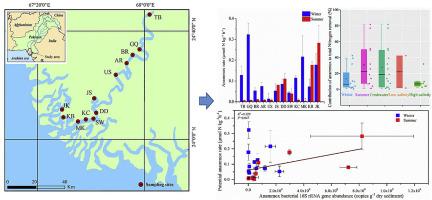Estuarine, Coastal and Shelf Science ( IF 2.6 ) Pub Date : 2020-07-26 , DOI: 10.1016/j.ecss.2020.106925 Fozia , Yanling Zheng , Lijun Hou , Zongxiao Zhang , Feiyang Chen , Dengzhou Gao , Guoyu Yin , Ping Han , Hongpo Dong , Xia Liang , Yi Yang , Min Liu

|
Anaerobic ammonium oxidation (anammox) is an important bioprocess for nitrogen removal and has been studied in estuarine environments. However, knowledge on anammox bacterial community dynamics and related controlling factors remains limited in these ecosystems. In this study, the community compositions, abundance, and activity of anammox bacteria in the surface sediments from the Indus Estuary were investigated along a salinity gradient, considering the links between the anammox bacterial community dynamics and environmental variables. The potential importance of anammox was also estimated for nitrogen removal. High anammox bacterial diversity was detected in the sediments of the Indus Estuary, including Kuenenia, Brocadia, Scalindua, Jettenia, and a novel anammox-like cluster. Kuenenia was identified as the dominant anammox bacteria in most samples. Anammox bacterial diversity was significantly correlated with sediment NO3- , while the distribution of anammox bacterial community was significantly related to temperature and sediment sulfide (P<0.05). The anammox bacterial abundance based on the 16S rRNA gene varied between 1.64 × 106 copies g-1 and 8.21 × 108 copies g-1, and was significantly correlated with sediment Fe(II). Based on an 15N isotope-tracing technique, potential anammox rates were found in the range 0.01 - 0.32 μmol N kg-1 h-1, and were controlled mainly by salinity, Fe(II), and TOC. It was estimated that the anammox bacteria contributed about 21.9 % to the total nitrogen loss, on average. These results show the importance of anammox bacteria for nitrogen transformation and removal in estuarine and coastal environments.
中文翻译:

厌氧铵氧化(厌氧氨)细菌的多样性,丰度和印度河口沉积物中的活性
厌氧铵氧化(厌氧氨)是重要的脱氮生物过程,并已在河口环境中进行了研究。但是,在这些生态系统中,关于厌氧氨氧化细菌群落动态及其相关控制因素的知识仍然有限。在这项研究中,沿盐度梯度调查了印度河口表层沉积物中厌氧细菌的群落组成,丰度和活性,并考虑了厌氧细菌群落动力学与环境变量之间的联系。还估计了厌氧氨气对于脱氮的潜在重要性。在印度河口的沉积物中发现了高厌氧菌细菌多样性,包括Kuenenia,Brocacadia,Scalindua,Jettenia,以及一个新颖的类似厌氧菌的簇。在大多数样品中,Kuenenia被确认为占主导地位的厌氧细菌。厌氧氨氧化细菌的多样性与沉积物NO被显著相关3 - ,而厌氧氨氧化细菌群落的分布显著有关温度和沉积物硫醚(P <0.05)。基于16S rRNA基因的厌氧菌细菌丰度在1.64×10 6拷贝g -1和8.21×10 8拷贝g -1之间变化,并且与沉积物Fe(II)显着相关。基于一个15 Ñ同位素示踪技术,潜在厌氧氨氧化速率为0.01发现- 0.32 μmol N kg -1 h -1,主要受盐度,Fe(II)和TOC的控制。据估计,厌氧细菌平均占总氮损失的21.9%。这些结果表明,厌氧细菌对河口和沿海环境中氮的转化和去除的重要性。







































 京公网安备 11010802027423号
京公网安备 11010802027423号